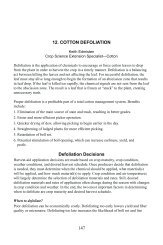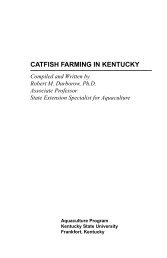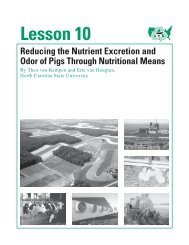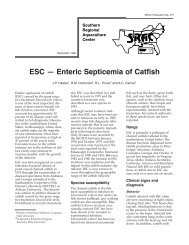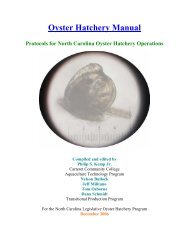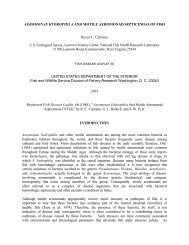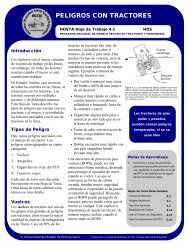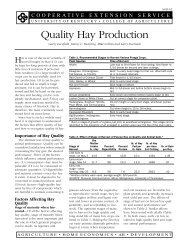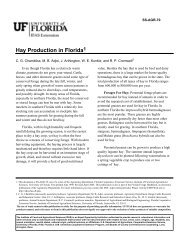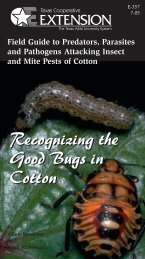Dryland Pastures in Montana and Wyoming - MSU Extension
Dryland Pastures in Montana and Wyoming - MSU Extension
Dryland Pastures in Montana and Wyoming - MSU Extension
You also want an ePaper? Increase the reach of your titles
YUMPU automatically turns print PDFs into web optimized ePapers that Google loves.
Appendix A. Descriptions of the dryl<strong>and</strong> forage cultivars most<br />
commonly used <strong>and</strong> recommended <strong>in</strong> <strong>Montana</strong> <strong>and</strong> Wyom<strong>in</strong>g.<br />
Specific site recommendations should consider local climate, soils, research <strong>and</strong><br />
experiences. Species listed <strong>in</strong> lower precipitation zones can be grown <strong>in</strong> higher<br />
zones, but not vice-versa. Most descriptions for cultivars conclude with <strong>in</strong>formation<br />
about the orig<strong>in</strong> of the cultivar.<br />
Moisture Range<br />
Common<br />
name Cultivar Description<br />
Less than 13 <strong>in</strong>ches precipitation<br />
Introduced Cool-Season Grasses<br />
Crested wheatgrass Bunchgrass; easy to establish; adapted for early use, cures poorly; good graz<strong>in</strong>g<br />
tolerance.<br />
Nordan St<strong>and</strong>ard type; good seedl<strong>in</strong>g vigor <strong>and</strong> forage yield; North Dakota 1953.<br />
Summit St<strong>and</strong>ard type; selected for seed yield, seed quality <strong>and</strong> foliage uniformity;<br />
Canada 1953.<br />
Fairway Fairway type; shorter, f<strong>in</strong>er stemmed <strong>and</strong> less productive on eastern pla<strong>in</strong>s<br />
dryl<strong>and</strong> sites than st<strong>and</strong>ard types; exceeds Nordan forage production at higher<br />
elevations; Canadian release.<br />
Parkway Fairway type; hay type; performs best at high elevations; selected for vigor,<br />
height <strong>and</strong> leaf<strong>in</strong>ess; Canadian release.<br />
Ephraim Fairway type; slightly rhizomatous; use for erosion control; Utah 1983.<br />
Hycrest Hybrid fairway X st<strong>and</strong>ard type; excellent seedl<strong>in</strong>g vigor; improved palatability<br />
<strong>and</strong> forage production; adapted to pla<strong>in</strong>s <strong>and</strong> <strong>in</strong>termounta<strong>in</strong> valleys; Utah 1984.<br />
CD-II Next generation of Hycrest selected for <strong>in</strong>creased vigor, forage production <strong>and</strong><br />
quality; Utah 1997.<br />
Douglas Hybrid st<strong>and</strong>ard type; produces less forage <strong>and</strong> is not as drought tolerant as<br />
other crested wheatgrasses; broader leaves; leafier plant that rema<strong>in</strong>s greener<br />
longer <strong>in</strong>to the grow<strong>in</strong>g season than st<strong>and</strong>ard; Utah 1997.<br />
Roadcrest A rhizomatous long-lived crested wheatgrass, produces less biomass <strong>and</strong> is<br />
15–25 percent shorter than other forage-type cultivars; best suited for a low<br />
ma<strong>in</strong>tenance turf; seedl<strong>in</strong>g vigor <strong>and</strong> drought resistance compares with other<br />
crested wheatgrass; Utah 1999.<br />
Dahurian wildrye<br />
Orchardgrass<br />
Paiute<br />
Russian wildrye<br />
Short-lived (2-3 years) bunchgrass; excellent germ<strong>in</strong>ation <strong>and</strong> quick establishment.<br />
James High post-harvest regrowth <strong>and</strong> seed production; Canada 1989.<br />
Arthur Similar to James, but heads out earlier; Canada 1989.<br />
V<strong>in</strong>all<br />
Cabree<br />
Bunchgrass; high forage palatability <strong>and</strong> livestock preference.<br />
<strong>Dryl<strong>and</strong></strong> orchardgrass; drought hardy; early spr<strong>in</strong>g pasture; w<strong>in</strong>ter hard<strong>in</strong>ess is<br />
poor where snow cover does not last all w<strong>in</strong>ter; Utah 1983.<br />
Bunchgrass; difficult to establish; seed<strong>in</strong>g depth critical; needs wide row<br />
spac<strong>in</strong>g (18 <strong>in</strong>. m<strong>in</strong>.); not well suited for hay.<br />
Average forage production <strong>and</strong> seed yield; poor seedl<strong>in</strong>g vigor, orig<strong>in</strong>al cultivar<br />
released <strong>in</strong> 1960 from North Dakota.<br />
Seedl<strong>in</strong>g vigor equal to Swift; less productive than Swift; Canadian release.<br />
Sawki Similar to V<strong>in</strong>all <strong>in</strong> seed yield <strong>and</strong> forage production; Canada 1963.<br />
— 23 —




